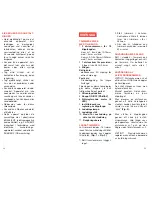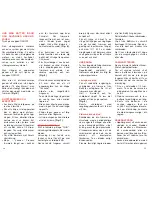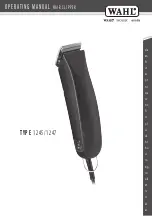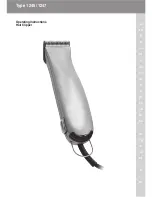
thin you hair, take a section of
hair (rest your little and ring
fingers on your scalp, using the
middle and index fingers to set
the length), hold 1 to 2 cm
below the cutting length. Then,
using the clipper, cut the
section of hair steeply and at
an angle to create a saw-
toothed 'edge'.
MAINTENANCE
Remove the cutting guide after
each use.
Cleaning the clipper blades
regularly will maintain their
optimal performance.
Removable blades
To make cleaning easier, the
BaByliss clipper blades can be
removed. Make sure the clipper
is turned off. Hold the clipper
with the blades pointing up and
remove them by pressing the
top of the blade.
(Fig. 8)
Brush the blades using the
cleaning brush to remove any
hair.
Self-lubricating blades
The blades of your clipper have
a reservoir pad that dispenses
the amount of oil necessary for
your clipper to operate properly,
every time. It is nevertheless
recommended that you
occasionally refill, when you
notice the clipper isn't performing
as well.
Remove the blades as
described above.
Carefully squeeze a few drops
of BaByliss oil onto the pad.
Then put the blades back on the
clipper.
BaByliss oil is specially
formulated for clippers, it will
not evaporate or slow the
blades down.
You can get new blades when
these are worn or damaged.
Ni-MH BATTERIES
This clipper has Nickel-Metal
Hydride batteries.
In an effort to protect the
environment, these batteries
should be removed and
properly disposed of when the
unit is no longer operating. To
remove the battery block for
disposal or recovery, follow
these instructions:
1.
First, unplug the clipper.
Remove the 3 screws on the
back, 2 at the top and 1 at
the bottom.
2. Open the clipper and remove
the batteries using wire
cutters.
3. To protect the environment,
do not dispose of your
batteries with your ordinary
household waste. For more
details on recovery of
materials and waste
treatment facilities, please
contact the waste disposal
services in your region.
SAFETY PRECAUTIONS
•
Stop using the clipper
immediately if the cord is
STARTING AND USING
Push the ON/OFF button.
The exclusive motor-management
system generates more power
when cutting 'difficult' areas.
The self-regulating motor
thereby maintains a steady
speed. The LEDs display the
compensation provided by the
motor-management system.
To turn the clipper off, press the
ON/OFF button.
To remove the cutting guide,
put it in the highest position (15
mm or 30mm) and push the
guide up using your thumbs
and holding it on either side.
(Fig. 4)
CUTTING TECHNIQUES AND
ADVICE FROM THE EXPERTS
• Use the clipper on clean, dry
hair.
• To familiarize yourself with the
clipper, begin with the cutting
guide for a longer cut, then, if
you want a shorter cut,
change the guide and/or
adjust the length by turning
the knob. You will soon know
the lengths of each guide and
each position..
•
Always move the clipper
against the direction of hair
growth.
• Begin at the nape. Place the
guide on the scalp and move
the clipper toward the crown
of your head. Move your
clipper slowly, pointing the
teeth of the guide slightly
upward. Keep the clipper in
contact with your head at all
times.
(Fig. 5)
• For the crown of the head,
move from front to back, that
is, from your forehead to the
crown of your head.
• For the finishing touches, that
is, around the nape and
sideburns, use the clipper
without a cutting guide. Turn
your clipper over and move it
from top to bottom.
(Fig. 6)
• If you want a length greater
than 30 mm, or if you are
experienced, you can create
'comb' or 'finger' cuts:
- Work without a cutting guide.
- Take up a small section of hair
with a comb or in your fingers.
- Move the comb or your fingers
along the section of hair to the
desired length.
- Cut your hair along the comb
or your fingers.
- Remove the cut hair using a
comb and check the evenness
of the cut regularly.
(Fig. 7)
Using the thinning guide
Switch the clipper to the 'THIN'
position. The thinning guide is in
front of the blades. This
technique allows you to thin out
hair to make styling easier.
The technique is particularly
good for the crown of the head
where hair is usually thicker. To
6
7





































